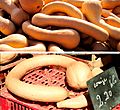Cucurbita moschata facts for kids
Quick facts for kids Cucurbita moschata |
|
|---|---|
 |
|
| Butternut squash, a variety of Cucurbita moschata | |
| Scientific classification | |
| Genus: |
Cucurbita
|
| Species: |
moschata
|
| Synonyms | |
|
|
Cucurbita moschata is a type of plant that includes many popular kinds of squash and pumpkin. It first grew in Central America or northern South America. These plants are known for being tough. They can handle hot, wet weather better than some other squash types. They also tend to resist diseases and insects well, especially the squash vine borer. Many pumpkin pie mixes you find in stores are made from C. moschata varieties.
Long ago, different types of Cucurbita plants were already in the Americas before people arrived. C. moschata is like a genetic link between different squash species. It is thought to be very similar to the original ancestor of all Cucurbita plants.
All squashes and pumpkins come from the Western Hemisphere. C. moschata varieties, like Cushaw and Winter Crookneck Squashes, grow on long vines. They are native to Mexico and Central America. This species and C. pepo (another squash type) likely started in the same area. Both were very important food sources for the native people there. They were almost as important as corn and beans. In some places, people ate the flowers, mature seeds, and the fruit's flesh.
Before Europeans came, C. moschata and C. pepo had spread across North America. They grew wherever the climate was right. Native peoples across what is now the United States grew them. Many still grow unique, hardy squashes and pumpkins that are not found in regular stores.
Popular Varieties of C. moschata
There are many different types of Cucurbita moschata. Here are some well-known ones:
- Al Hachi – This is a winter squash from Kashmir. It is often dried and used in cooking.
- Aehobak – Also called Korean zucchini, this is a summer squash.
- Brazilian crook neck – Known as Abóbora de pescoço or Abóbora seca in Brazil. It is a large squash with a curved neck. It has deep orange flesh and dark green skin with orange spots.
- Butternut squash – This is a very popular winter squash in North America. It has a sweet, nutty taste.
- Calabaza – A common winter squash grown in the Caribbean, tropical America, and the Philippines.
- Dickinson pumpkin – This special type is used by Libby's for their canned pumpkin products.
- Giromon – A large, green squash grown mainly in the Caribbean. People in Haiti use it to make a traditional soup called "soupe giromon".
- Golden Cushaw – This squash looks similar to other "cushaw" types but is a different species.
- Loche – These squashes come from Peru and are a special local variety.
- Liscia – This variety grows quickly and is ready to harvest in about 115 to 130 days.
- Long Island cheese pumpkin – This pumpkin looks like a wheel of cheese. It has a similar shape, color, and texture.
- Musquée de Provence – Also called Moscata di Provenza or Fairytale pumpkin. This is a large squash from France. It has sweet, orange flesh and is often sold in slices because of its size.
- Naples long squash – Known as Courge pleine de Naples in France. It is a very long squash with dark green skin and a small bulb at one end. It can weigh 10 to 25 kg (22 to 55 pounds).
- São Paulo pumpkin – Or Abóbora paulista. This variety looks like a butternut squash but has clear white and green stripes.
- Seminole pumpkin – An old type of squash first grown by the Seminole Native Americans in Florida.
- Tromboncino – This is a summer squash, also known as "Zucchetta".
Images for kids
See also
 In Spanish: Cucurbita moschata para niños
In Spanish: Cucurbita moschata para niños












